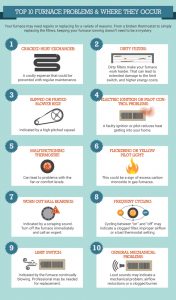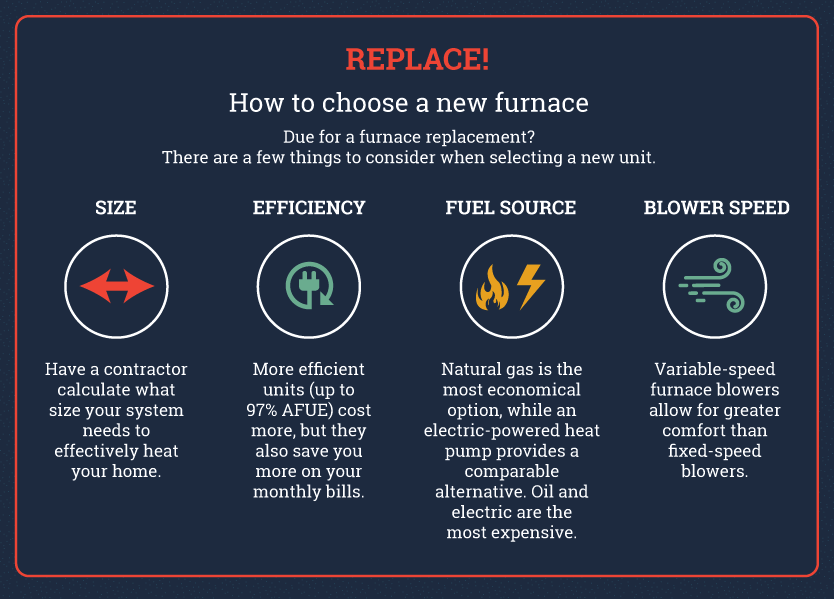Furnace Maintenance – Repair or Replace?
With the right furnace maintenance and care, a heating system can last decades. Manufacturers, however, recommend that you replace them every 15 to 20 years because new furnaces are more reliable and provide energy savings that make them worth the cost. When you have an older furnace or one that seems to need frequent repairs, knowing when it’s a good time to buy a replacement could save you money and prevent unnecessary stress.
Indications That You Might Need a New Furnace
Age
On average, furnaces last about 15 to 20 years. If you have an older furnace that requires more repairs than usual, upgrading to a newer system is a good idea.
Safety
If your furnace poses a safety hazard, replace it. One of the main concerns with faulty heating systems that use natural gas is carbon monoxide poisoning. Carbon monoxide is a colorless, odorless gas, so it’s a good idea to keep a carbon monoxide detector near the furnace and have a professional maintain the unit at least once a year. You can schedule an appointment with us here.
Warning signs of gas-related problems with a natural gas furnace include:
- A pilot light that’s yellow; it should be blue
- A flickering pilot light
- Soot streaks around the furnace
- Excess moisture on the windows and walls around a furnace
- Excessive rust on appliance jacks and flue pipes
Repair Costs
A furnace that works well should not need a repair more than once every two years. If you have a furnace that’s 10 years old or older, consider a replacement if the repair cost is 10 percent of the replacement cost. For example, if a repair is over $200 and new furnace is $2,000, a replacement may be more cost effective in the long run. Here’s how to troubleshoot your furnace.
If a furnace’s repair cost is 50 percent of the replacement cost, buy a new furnace, regardless of the current unit’s age. Similarly, if you’ve already spent about 50 percent of the replacement cost in furnace repairs, a new unit may ultimately be more cost effective, especially considering the tax benefits and increased energy efficiency savings that you may receive.
Energy Efficiency
A new furnace is considerably more energy efficient than one that is 10 years old, even if it works well. Older furnaces and those in need of repairs tend to use more energy, and your power bills will only increase with time.
When looking at new furnaces, pay attention to its AFUE (annual fuel utilization efficiency) rating—the higher the AFUE, the more efficient the unit. A furnace with an 80 percent AFUE, for example, uses 80 percent of the fuel consumed to heat a home. The remaining 20 percent goes up the flue. So, it only wastes 20 cents of every $1 spent to heat a home. If your current furnace has a 60 percent AFUE, for instance, and you upgrade to a unit with a 90 percent AFUE, you’ll save over $33 for every $100 that you spend on heating costs.
Don’t Procrastinate on Furnace Maintenance and Repairs
Annual furnace maintenance is great for a system tune-up so the furnace can run more efficiently and reliably throughout the year. During the maintenance process, the HVAC professional may also find smaller problems that are inexpensive to remedy before they turn into expensive or dangerous issues.
If you notice any of the following with your furnace, call a Portland HVAC professional soon:
- Strange sounds
- Your home feels cold or drafty, even when you turn up the heat
- Pilot light problems
- The furnace doesn’t turn on or stay on
- Your home is more dusty than usual
While it may seem easier to put off a furnace repair, doing so may:
- Put your family’s health and safety at risk: Never take a chance with appliances that use natural gas
- Be more expensive: Time has a way of turning small, inexpensive repairs into costly headaches
- Waste energy: Furnaces that don’t work well use more energy to heat a space
- Make your home feel uncomfortable: Why pay high energy bills when your home still feels drafty
If you have an older or problematic furnace, talk an HVAC specialist at AAA Heating & Cooling. We’ll assess your furnace’s current situation and history to make a recommendation that’s financially sound, keeps your family safe, and aligns with your needs. Get in touch with us today.
What Are the Most Common Furnace Problems?
When the cool fall and winter weather arrive, hundreds of people call Portland furnace repair experts because of a problem with their heating system. Whether it’s a commercial or residential setting, the same basic problems plague furnaces. By knowing what the most common furnace problems are, you can take proactive measures to prevent them.
Top 10 Furnace Problems
Below are the 10 most common furnace problems. Read on for advice on how to repair and fix future furnace problems.
1. Lack of maintenance
You fail to schedule annual furnace maintenance and inspections that could prevent unexpected problems and breakdowns. These routine inspections can help the appliance run more efficiently and reliably.
2. Dirty Filters
Dirty or clogged air filters reduce airflow, making a furnace work harder to circulate. In some cases, a clogged filter may damage the limit switch, which controls the fan.
3. Wear and tear
Normal wear and tear can cause airflow problems, heat control-related problems or even overheating.
4. Electric ignition or pilot control problems
A faulty ignition or pilot could make it difficult to heat a home or commercial space. Thermocouple problems, drafts or clogs in the appliance may result in an unlit pilot light.
5. Malfunctioning thermostat
A faulty thermostat can lead to problems with the fan or comfort levels.
6. The furnace doesn’t heat at all
A furnace that doesn’t perform its main task may have problems with the thermostat setting, power, gas or the pilot light.
7. The furnace doesn’t heat enough
In addition to a clogged filter, a furnace may not produce enough heat if it’s the wrong size for the space.
8. Frequent cycling
Cycling between the “On” and “Off” modes may indicate a clogged filter, improper airflow or a bad thermostat setting.
9. The blower continuously runs
Blower issues may indicate a problem with the limit switch, which a professional may need to replace.
10. The furnace is too noisy
Rumbling, squeaking and rattling aren’t normal. The sounds may indicate a mechanical problem, airflow reductions or a clogged burner.
Steps You Can Take To Maintain Your Furnace
- Maintenance: Every year, at the end of the summer or beginning of fall, scheduling routine maintenance with a furnace repair specialist is crucial to maintain your furnace. The professional will get the unit ready for the upcoming cool weather and fix problems that could cause breakdowns or expensive repairs during busy winter months.
- Check the circuit breaker and power supply: If the furnace stops working or the thermostat’s screen is blank, check if the circuit breaker tripped or blew a fuse. Also, make sure the power cord is plugged into an outlet.
- Reduce drafts: If a draft causes problems with the pilot light, you may need to close the windows or doors in the room.
- Change the air filters: Dirty air filters lead to a multitude of furnace problems. Clean or replace the filter one a month, according to the manufacturer’s directions.
- Check the thermostat: If it seems as if your furnace doesn’t produce any heat, check the battery level in the thermostat. In some models, simply replacing the battery may do the trick.
If nothing seems to work, you may need to purchase a new furnace or have an furnace technician stop by to repair your furnace.
Tasks To Leave To a Furnace Repair Expert
When troubleshooting your appliance doesn’t solve your furnace issues, never hesitate to contact a trained HVAC contractor. Any furnace, regardless of its age, may pose combustion or gas-related safety hazards, so it’s always a good idea to have an expert examine the unit and suggest the best course of action.
- Furnace installation: If you need to replace your furnace, use a furnace contractor’s expertise to determine the right type and size for your home or commercial space.
- Ignition control or pilot light problems: As problems may result from clogged components or faulty electrical components, leave ignition issues to the experts.
- Natural gas or propane problems: When you suspect problems with the gas feed or valve because of a malfunction with the gas pressure regulator, call a professional for help.
- Mechanical issues: Unless you received training to repair furnaces, let professionals handle problems related to mechanical wear and tear. Otherwise, you may void the warranty on the appliance or accidentally cause a larger problem.
We are your go-to Portland HVAC company! For over 60 years our team of furnace repair experts have worked with both commercial and residential clients. Contact us today!

Furnace Maintenance Tips to Keep You Warm This Winter [Infographic]
Regular furnace maintenance is key to keeping it in tip top shape and keeping you warm! Learn the signs that your furnace may need a check up, whether your should repair or replace and how to tell if your furnace is energy efficient. All of this and more is explained in our latest infographic.
Click to view in full size

